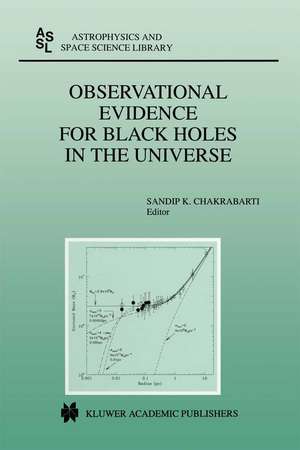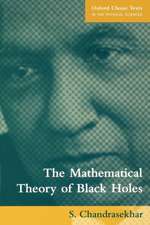Observational Evidence for Black Holes in the Universe: Proceedings of a Conference held in Calcutta, India, January 10–17, 1998: Astrophysics and Space Science Library, cartea 234
Editat de Sandip K. Chakrabartien Limba Engleză Paperback – 9 noi 2012
Black holes are enigmatic objects since it is impossible to locate them through direct observations. State-of-the-art theoretical works and numerical simulations have given us enough clues of what to look for. Observations, from both ground and space-based missions, have been able to find these tell-tale signatures. This book is a compendium of our present knowledge about these theories and observations. Combined, they give a thorough idea of whether black holes, galactic as well as extragalactic, have been detected or not. Forty-one experts of the subject have contributed to this volume to make it the most comprehensive to date.
Din seria Astrophysics and Space Science Library
- 24%
 Preț: 799.10 lei
Preț: 799.10 lei - 15%
 Preț: 647.92 lei
Preț: 647.92 lei - 18%
 Preț: 983.81 lei
Preț: 983.81 lei - 18%
 Preț: 790.28 lei
Preț: 790.28 lei -
 Preț: 359.86 lei
Preț: 359.86 lei -
 Preț: 389.71 lei
Preț: 389.71 lei - 20%
 Preț: 691.14 lei
Preț: 691.14 lei - 20%
 Preț: 816.18 lei
Preț: 816.18 lei - 18%
 Preț: 1011.27 lei
Preț: 1011.27 lei -
 Preț: 402.56 lei
Preț: 402.56 lei - 15%
 Preț: 664.93 lei
Preț: 664.93 lei -
 Preț: 398.15 lei
Preț: 398.15 lei - 18%
 Preț: 954.77 lei
Preț: 954.77 lei -
 Preț: 411.04 lei
Preț: 411.04 lei - 18%
 Preț: 1225.31 lei
Preț: 1225.31 lei - 18%
 Preț: 1843.29 lei
Preț: 1843.29 lei -
 Preț: 393.13 lei
Preț: 393.13 lei -
 Preț: 400.26 lei
Preț: 400.26 lei - 18%
 Preț: 953.82 lei
Preț: 953.82 lei - 18%
 Preț: 960.61 lei
Preț: 960.61 lei -
 Preț: 398.35 lei
Preț: 398.35 lei -
 Preț: 390.84 lei
Preț: 390.84 lei -
 Preț: 413.76 lei
Preț: 413.76 lei -
 Preț: 416.64 lei
Preț: 416.64 lei - 18%
 Preț: 947.67 lei
Preț: 947.67 lei -
 Preț: 404.51 lei
Preț: 404.51 lei - 18%
 Preț: 956.50 lei
Preț: 956.50 lei -
 Preț: 403.75 lei
Preț: 403.75 lei - 18%
 Preț: 1229.40 lei
Preț: 1229.40 lei - 18%
 Preț: 1224.99 lei
Preț: 1224.99 lei -
 Preț: 404.29 lei
Preț: 404.29 lei - 15%
 Preț: 654.77 lei
Preț: 654.77 lei - 18%
 Preț: 1248.20 lei
Preț: 1248.20 lei - 18%
 Preț: 955.25 lei
Preț: 955.25 lei - 18%
 Preț: 1846.28 lei
Preț: 1846.28 lei - 18%
 Preț: 1233.06 lei
Preț: 1233.06 lei - 18%
 Preț: 1234.77 lei
Preț: 1234.77 lei
Preț: 395.09 lei
Nou
Puncte Express: 593
Preț estimativ în valută:
75.61€ • 82.10$ • 63.51£
75.61€ • 82.10$ • 63.51£
Carte tipărită la comandă
Livrare economică 22 aprilie-06 mai
Preluare comenzi: 021 569.72.76
Specificații
ISBN-13: 9789401059954
ISBN-10: 9401059950
Pagini: 416
Ilustrații: XII, 399 p.
Dimensiuni: 160 x 240 x 22 mm
Greutate: 0.58 kg
Ediția:Softcover reprint of the original 1st ed. 1999
Editura: SPRINGER NETHERLANDS
Colecția Springer
Seria Astrophysics and Space Science Library
Locul publicării:Dordrecht, Netherlands
ISBN-10: 9401059950
Pagini: 416
Ilustrații: XII, 399 p.
Dimensiuni: 160 x 240 x 22 mm
Greutate: 0.58 kg
Ediția:Softcover reprint of the original 1st ed. 1999
Editura: SPRINGER NETHERLANDS
Colecția Springer
Seria Astrophysics and Space Science Library
Locul publicării:Dordrecht, Netherlands
Public țintă
ResearchCuprins
Accretion Disk Theory: From the Standard Model until Advection.- Accretion Disks around Black Holes: Twenty Five Years Later.- Viscosity in Accretion Disks.- Shock Formation in Adiabatic Accretion Flows around a Kerr Black Hole.- Rotating Accretion Flows near a Black Hole: A Numerical Study.- Simulations of Shocks with Smoothed Particles Hydrodynamics Method.- Nucleosynthesis in Advective Accretion Disks around Galactic and Extra-Galactic Black Holes.- Computation of Mass-Outflow Rates from Advective Accretion Disks around Black Holes.- Black Hole Solutions of Einstein’s Equations an Overview.- Water Mega Masers in NGC4258.- Supermassive Black Holes in Galactic Nuclei — Observational Evidence and Some Astrophysical Consequences.- Tidal Disruption of a Star by a Massive Black Hole.- Multifrequency Monitoring of Blazars.- The OJ287 Supermassive Binary Black Hole Model and the New Unified Scheme for the Agns.- High Energy Gamma-Ray Emission from Blazars: Egret Observations.- Strong Gravity and X-Ray Spectroscopy.- My Involvement in the Early Years of Radio Astronomy.- Radio Observations of Active Galactic Nuclei: Evidence for Disks and Black Holes.- High Proper Motion Stars in the Vicinity of Sgr A*: Evidence for a Supermassive Black Hole at the Center of Our Galaxy.- Black Holes in Our Galaxy Dynamical Evidence.- Outbursts in Black Hole X-Ray Transients: Clues from Multiwavelength Observations.- The High-Energy Spectra of Accreting Black Holes: Viewing the Matter as It Disappears Down the Schwarzschild Drain.- X-Ray Spectral Variability of Black Hole Binaries.- Quasi-Periodic Oscillations in the X-Ray Flux from the Black Hole Candidates.- X-Ray Properties of GRS 1915+105.- X-Ray Observation of Black Hole Novae.- A Transition Disk Model Fit to Cygnus X-1.- Are theX-Rays Coming from the Inside of the Accretion Disk of the Black Hole?.- List of Participants.- Author Index.
Recenzii
`There are a few good review articles in this proceedings, most being suitable for anyone working on the observtional signature of accretion flows. ... I would recommend your library to purchase a copy, if only to help researchers in the field to understand the underlying principles behind the papers published by this school of thought.'
The Observatory, 119
The Observatory, 119












